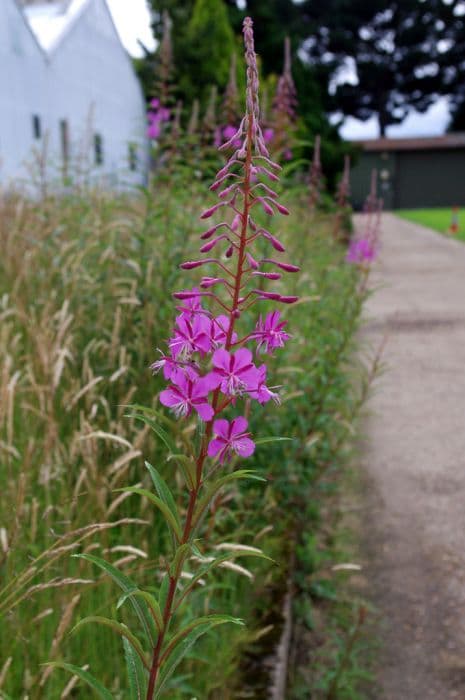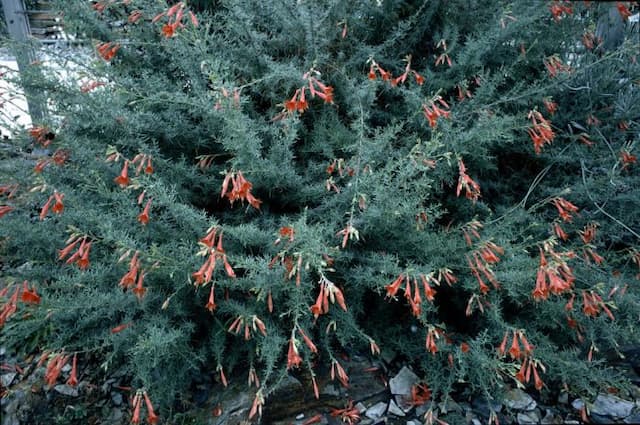Fuchsia 'Rivendell' Fuchsia 'Rivendell'

ABOUT
'Rivendell' is a bushy, deciduous shrub producing single flowers in summer and autumn with lavender pink sepals and an aubergine-coloured corolla that fades to a deep burgundy red
About this plant
 Names
NamesFamily
Onagraceae
Synonyms
Lady's Eardrops, Fairy Bells, Hummingbird Fuchsia
Common names
Fuchsia 'Rivendell'
 Characteristics
CharacteristicsLife cycle
Perennials
Foliage type
Deciduous
Color of leaves
Green
Flower color
Mixed
Height
1-2 feet (30-60 cm)
Spread
1-2 feet (30-60 cm)
Plant type
Shrub
Hardiness zones
9
Native area
Central America
Benefits
 General Benefits
General Benefits- Ornamental Value: Fuchsia 'Rivendell' offers striking pendulous flowers in vibrant colors, enhancing the visual appeal of gardens and landscapes.
- Attracts Pollinators: The brightly colored blossoms attract hummingbirds and beneficial insects, supporting local ecosystems.
- Shade Tolerance: This plant can thrive in partial shade, making it a versatile choice for various garden locations.
- Container Gardening: Fuchsia 'Rivendell' is suitable for pots and hanging baskets, allowing for decorative flexibility in small spaces and patios.
- Long Blooming Period: With proper care, it can provide a long season of blooms from spring through fall.
- Easy Propagation: It can be easily propagated from cuttings, allowing gardeners to expand their collection without additional costs.
- Range of Uses: Fuchsia 'Rivendell' can be used in mixed borders, as a focal point, or for adding vertical interest due to its growth habit.
 Medical Properties
Medical PropertiesThis plant is not used for medical purposes.
 Air-purifying Qualities
Air-purifying QualitiesThis plant is not specifically known for air purifying qualities.
 Other Uses
Other Uses- The Fuchsia 'Rivendell' can be used in terrariums to add vibrant color and texture due to its drooping flowers and dark foliage.
- Pressed flower art can benefit from the inclusion of Fuchsia petals, which can be preserved and used to create intricate designs and patterns.
- Fuchsia plants can serve as inspiration for artists and designers, who may use the distinct shape and color of its flowers in jewelry making or fashion design.
- As a nectar plant, the Fuchsia 'Rivendell' can be used to attract and support pollinators like hummingbirds in a wildlife garden.
- Fuchsia blooms can be used in cake decorating as natural and edible adornments, contributing a splash of color and elegance to desserts.
- Fuchsias can be used in educational settings such as schools and botanical gardens to teach about plant propagation through cuttings.
- The Fuchsia 'Rivendell' can be incorporated into themed garden displays such as fairy or miniature gardens due to their whimsical appearance.
- Photographers can use Fuchsia plants as a live backdrop or focus for macro and botanical photography due to their striking flowers.
- Fuchsias can be used as part of a natural dye garden, where plants are grown for the purpose of extracting dyes for fabrics and crafts.
- Garden hobbyists may use Fuchsia 'Rivendell' to practice and develop bonsai skills, as some Fuchsia species can be trained into bonsai forms.
Interesting Facts
 Feng Shui
Feng ShuiFuchsia is not used in Feng Shui practice.
 Zodiac Sign Compitability
Zodiac Sign CompitabilityFuchsia is not used in astrology practice.
 Plant Symbolism
Plant Symbolism- Confiding Love - Fuchsia flowers, with their delicate and intricate blooms, are often associated with confiding love, signifying deep affection and trust within a relationship.
- Elegance and Grace - The elegant hanging blossoms of the Fuchsia plant symbolize a graceful attitude and beauty in comportment.
- Harmony and Balance - The symmetry of the fuchsia flower represents harmony and balance in life, reminding us to maintain equilibrium in our daily affairs.
- Good Taste - Often found in ornamental gardens and in graceful arrangements, fuchsias are considered to represent good taste in aesthetics and manners.
- Ambiguity and Subtlety - With its unique shape and combination of two-toned petals, the Fuchsia can symbolize complexity of emotions and the subtleties in relationships.
 Water
WaterFor Fuchsia 'Rivendell', commonly known as hardy fuchsia, it is important to maintain consistently moist soil without waterlogging it. During the growing season, water the plant thoroughly whenever the top inch of soil feels dry to the touch, which typically amounts to once or twice a week. The exact frequency will depend on climate and weather conditions, but a good rule of thumb is to apply about 1 gallon of water per watering for an established plant in a standard garden setting. Reduce watering in the winter when the plant is not actively growing. Always ensure that the pot or area where the hardy fuchsia is planted has good drainage to prevent root rot.
 Light
LightHardy fuchsia thrives in bright, indirect light and should be protected from the harsh afternoon sun, making it ideal for spots that receive morning sun and afternoon shade or filtered sunlight throughout the day. Do not place it in deep shade as this can lead to poor flowering. A north-facing window or a spot under a tree that provides dappled sunlight can be perfect locations for indoor and outdoor hardy fuchsias, respectively.
 Temperature
TemperatureHardy fuchsia prefers a moderate climate and performs well in a temperature range between 60°F to 75°F. It is capable of surviving temporary dips down to about 40°F, but frost can be harmful, so it's important to protect the plant from freezing temperatures. Ideal growing conditions would avoid any extremes, keeping the hardy fuchsia away from both cold drafts and hot, dry air.
 Pruning
PruningPruning hardy fuchsia helps maintain its shape, encourage bushier growth, and promote more abundant flowering. Prune in early spring before new growth begins, removing any dead or weak branches and shortening last year's growth by about a quarter to one-third to stimulate new buds. Additionally, deadheading spent flowers throughout the blooming season encourages more blooms.
 Cleaning
CleaningAs needed
 Soil
SoilThe Fuchsia 'Rivendell', commonly referred to as hardy fuchsia, thrives best in a soil mix that is well-draining, fertile, and moisture-retentive. A blend containing peat moss, loamy garden soil, and perlite or sand can achieve this. The ideal soil pH range should be between 6.0 and 7.0 for optimal growth and flowering.
 Repotting
RepottingHardy fuchsias like Fuchsia 'Rivendell' should be repotted every 2 to 3 years or when the roots become pot-bound. This typically involves moving the plant to a slightly larger pot and refreshing the soil to ensure continued healthy growth.
 Humidity & Misting
Humidity & MistingFuchsia 'Rivendell' prefers high humidity levels for optimal growth. Aim to maintain a humidity level around 60-70% for these plants, though they can tolerate a range between 50% and 80% as long as they are not exposed to dry air for extended periods.
 Suitable locations
Suitable locationsIndoor
Place in bright, indirect light, ensure high humidity, and keep soil moist.
Outdoor
Partial shade, shelter from wind, moist fertile soil, regular feeding.
Hardiness zone
6-11 USDA
 Life cycle
Life cycleFuchsia 'Rivendell', commonly known as hardy fuchsia, begins its life cycle with germination, where the seeds sprout in moist, well-draining soil under partial shade. After germination, seedlings emerge and grow into juvenile plants, developing a root system and foliage. As the plant matures, it enters the vegetative stage, where it grows vigorously, producing distinctive, pendulous flowers with a combination of pink, purple, and white hues. Following the flowering stage, the plant sets fruit, which are small, dark purple berries, typically not eaten due to their insubstantial flesh. In a perennial cycle, after flowering and fruiting, the plant enters dormancy during colder months, with foliage dying back to the ground. With the return of warmer temperatures, the fuchsia emerges from dormancy, producing new shoots and leaves, and the cycle repeats.
 Propogation
PropogationPropogation time
Spring-Early Summer
Fuchsia 'Rivendell', commonly known as the Fuchsia, is most popularly propagated through stem cuttings. This process is typically done in late spring to early summer when the plant's growth is most active. To propagate Rivendell Fuchsias, take a healthy, non-flowering shoot about 2 to 4 inches long and strip the lower leaves off. Dip the cut end into a rooting hormone to encourage root development and insert the cutting into a well-draining soil mix. Keep the soil moist and place the cutting in a warm area with indirect sunlight. Roots generally develop within a few weeks, after which the new Fuchsia can be transplanted into a larger pot or garden setting.









